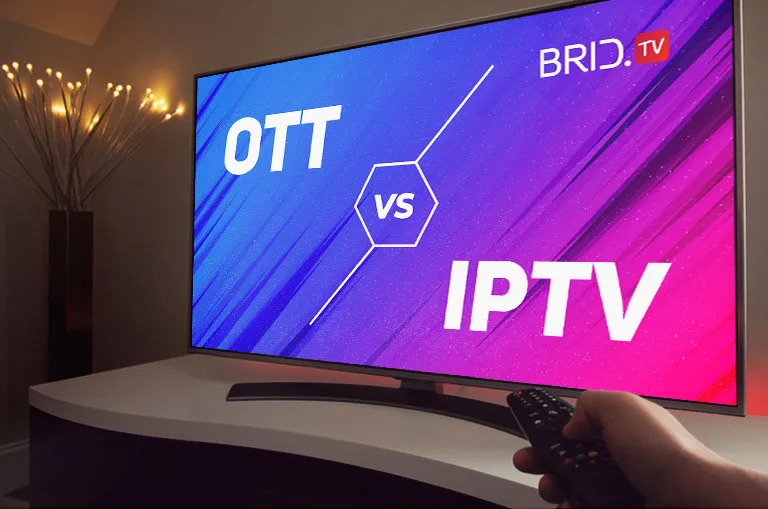With online video becoming increasingly popular, 21% of U.S. households have already cut the cord, while many more are following suit daily. Research by Techjury also predicts that cable and satellite TV penetration is to drop by 26% by 2030. This consumer trend of switching from cable to internet-based streaming services is forcing broadcasters worldwide to reform their business models.
Traditional TV providers are left with a predicament — do they go with the crowd and adopt an on-demand video model, or do they stick to the increasingly dying cable TV industry? The answer should be clear.
Consumers no longer have the time to sit in front of a TV at a fixed time every day to watch their favorite shows. And with internet-based streaming services, they don’t have to anymore. This increased accessibility is the primary driving force behind the TV industry revolution.
But what are your options as a TV provider or publisher if you want to pivot your business and switch to online video delivery? There are two primary internet-based delivery models to consider: OTT and IPTV.
But what are the differences between the two models, and how do you choose the best one for your business? Let’s find out!
What Is OTT?
Over-the-top (OTT) content refers to any type of video or TV program delivered or streamed over the public internet. This type of content delivery gives users complete freedom over what they consume, unlike with traditional TV where the provider controls the programming.
The most notable advantage of OTT TV is that viewers can access it from any device with an internet connection. Here are some of the most common OTT devices out there:
- Computers (Desktop, Laptops)
- Smart TVs
- Mobile Phones
- Gaming Consoles
- OTT Streaming Devices (e.g., Roku Streaming Stick, Fire TV Stick)
The best part about OTT broadcasting is that it’s not reserved for large publishers and TV providers — even small creators and businesses can make an OTT app and use it to grow their brand. The accessibility of over-the-top services makes OTT streaming an excellent opportunity for anyone looking to get into the online video business.
How Does OTT Work?
OTT services use a free transmission system to deliver videos to an OTT box or device in unicast form. Each OTT viewer must connect to the origin server (the server that delivers the content) to play videos. That means each OTT content stream acts as a one-to-one transmission.
The role of ISPs in OTT streaming is just to provide the infrastructure necessary for content streams to connect to end-user devices. And since OTT streaming services don’t need their own infrastructure, their cost of operation is lower and services cheaper.
However, the above comes with one issue — OTT services are highly dependent on a user’s internet speed. And since OTT infrastructure doesn’t support multicasting, having multiple active streams on a single network can eat up users’ bandwidth.
Most OTT providers circumvent this issue by using an OTT platform with an HTML5 player that supports adaptive bitrate streaming technology. ABR tech is a must for an OTT provider to ensure the best possible user experience. This technology enables providers to dynamically switch between streams of different quality renditions based on their users’ bandwidth. So viewers with slower internet speeds will get served lower quality video but without any interruptions or buffering.

What Is IPTV?
Internet Protocol Television (IPTV) is a controlled video and audio content delivery method that serves content through a privately managed network based on the Internet protocol (IP). These networks can include LAN, WAN, or ISP networks.
Like OTT, IPTV bypasses the traditional cable or satellite channels but in a more isolated ecosystem. That is why they require set-top boxes connected to a router to operate.
One of the most significant advantages of IPTV is that it supports multicasting, i.e., multiple users can view IPTV content across multiple devices simultaneously without compromising bandwidth consumption. That makes IPTV the prime alternative to cable TV for users with slow internet speeds. However, that also means users won’t be able to access IPTV on the go due to the local network limitations, but they will get a higher image and audio quality.
How Does IPTV Work?
IPTV services store videos and TV programs on a remote server and distribute them to end-users whenever they request playback. Once they do, the server uses a one-to-many distribution technique to deliver the content to all IP addresses on the network that request playback. Because of that, IPTV uses bandwidth efficiently and doesn’t put much strain on users’ internet.
Setting up an IPTV service is more challenging and expensive than its OTT counterpart, though. IPTV providers must supply customers with appropriate hardware because the service relies on a closed, controlled network to deliver content. Here’s what users will need to set up IPTV:
- Internet Connection
- A Router
- A Set-Top Box
Although IPTV relies on internet-based content delivery, it still isn’t entirely wireless. Users will have to connect a set-top box to the internet, usually via cable, to decode the receiving signal and display content on their TVs. In contrast, most OTT services only require an internet connection and to download an app to watch.
OTT vs. IPTV — What’s Different?
Although OTT and IPTV both work on similar principles and rely on the internet for content delivery instead of cable or satellite, they have quite a few crucial differences.
1. Network Type
OTT delivers content through an open network (public internet) while IPTV operates in a closed network ecosystem (LAN, WAN). Because of that, IPTV offers smoother content delivery as it doesn’t consume your internet’s bandwidth, while OTT services entirely rely on it for playback.
2. Monetization Models
OTT services often use a freemium (hybrid) monetization model, while IPTV services almost exclusively monetize through SVOD. OTT publishers often combine free plans with ad-based monetization and subscription-based or pay-per-view models for premium content and advanced features.
3. Content Quality
IPTV offers a smoother user experience and higher audio and video quality due to operating in a closed ecosystem. Since OTT services rely on the public internet for playback, their capabilities in terms of content quality are limited.
4. Accessibility
Users can download OTT apps and play their favorite shows across dozens of devices anywhere, anytime, as long as they have an internet connection. That includes playing your favorite videos on the go. Conversely, IPTV is limited to devices within your household, as the service operates in a closed network and requires connection to its set-top box and router.
5. Equipment
IPTV requires a set-top box and a router to operate, while OTT doesn’t need any external hardware to function. That is because most OTT services work through a dedicated app. Although some OTT services come with their own devices, they are necessary only if you don’t have a smart TV.
6. Service Reach
OTT services cater to global audiences as signing up for one is as simple as creating an account online and launching a stream. However, since local internet service providers offer IPTV services, they are always localized.
7. Operational Costs
Launching and distributing an OTT service is much cheaper for publishers than its IPTV counterpart. The primary reason is that launching an IPTV service requires investing in infrastructure and gear, so it’s mostly the local ISPs that offer this service. On the other hand, OTT providers can get their content delivery and monetization needs covered by a versatile OTT platform.
8. Price
Most OTT services offer a free, ad-supported plan anyone can use. But even if they don’t, they are pretty affordable due to their lower operational costs (usually around the $10/mo price point). IPTV services don’t have that luxury, though, and come at a steeper price due to higher expenses ($15–$30/mo on average).
The Verdict — So Which Is Better?
Now that we have covered the primary differences between OTT and IPTV, here’s a quick rundown of the winners in each category.
| Category | OTT | IPTV |
|---|---|---|
| Network Type | + | |
| Monetization Models | + | |
| Content Quality | + | |
| Accessibility | + | |
| Equipment | + | |
| Service Reach | + | |
| Operational Costs | + | |
| Price | + |
As you can see, OTT takes an overwhelming victory in most categories. However, despite these results, it’s impossible to disregard IPTV’s advantages in terms of control and content quality. That’s why we can’t say that one is distinctly better than the other. Both OTT and IPTV have their pros and cons.
OTT is more cost-effective for both providers and consumers and more flexible overall. On the other hand, IPTV offers better content quality and scalability at the expense of higher operational costs. So whether you choose to launch an OTT or IPTV streaming service will depend entirely on your business goals and budget.
Do you want to launch an affordable streaming service and reach a global audience? Find a reliable OTT platform and launch an OTT app!
Do you want to make a name for yourself in your local market with superior, high-quality video and audio content quality and buffer-free delivery? Consider getting into the IPTV industry!
If you decide in favor of OTT and need help launching and monetizing an OTT app, we at TargetVideo can help you. Publishers can use our Android, iOS, and tvOS SDKs to integrate our lightweight HTML5 player with their OTT apps and enjoy all the advanced OTT monetization options that come with it. Check out our OTT solutions and get in touch if you have any questions or need help with anything!

